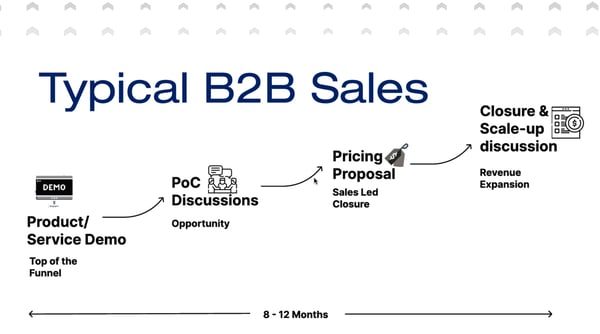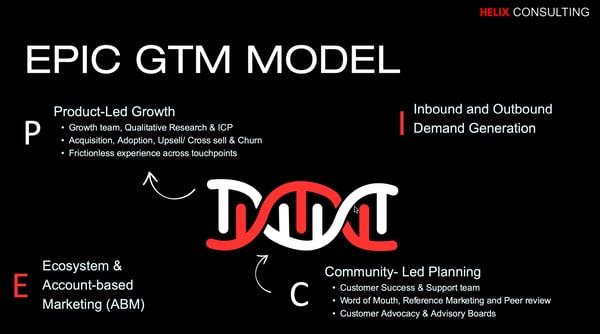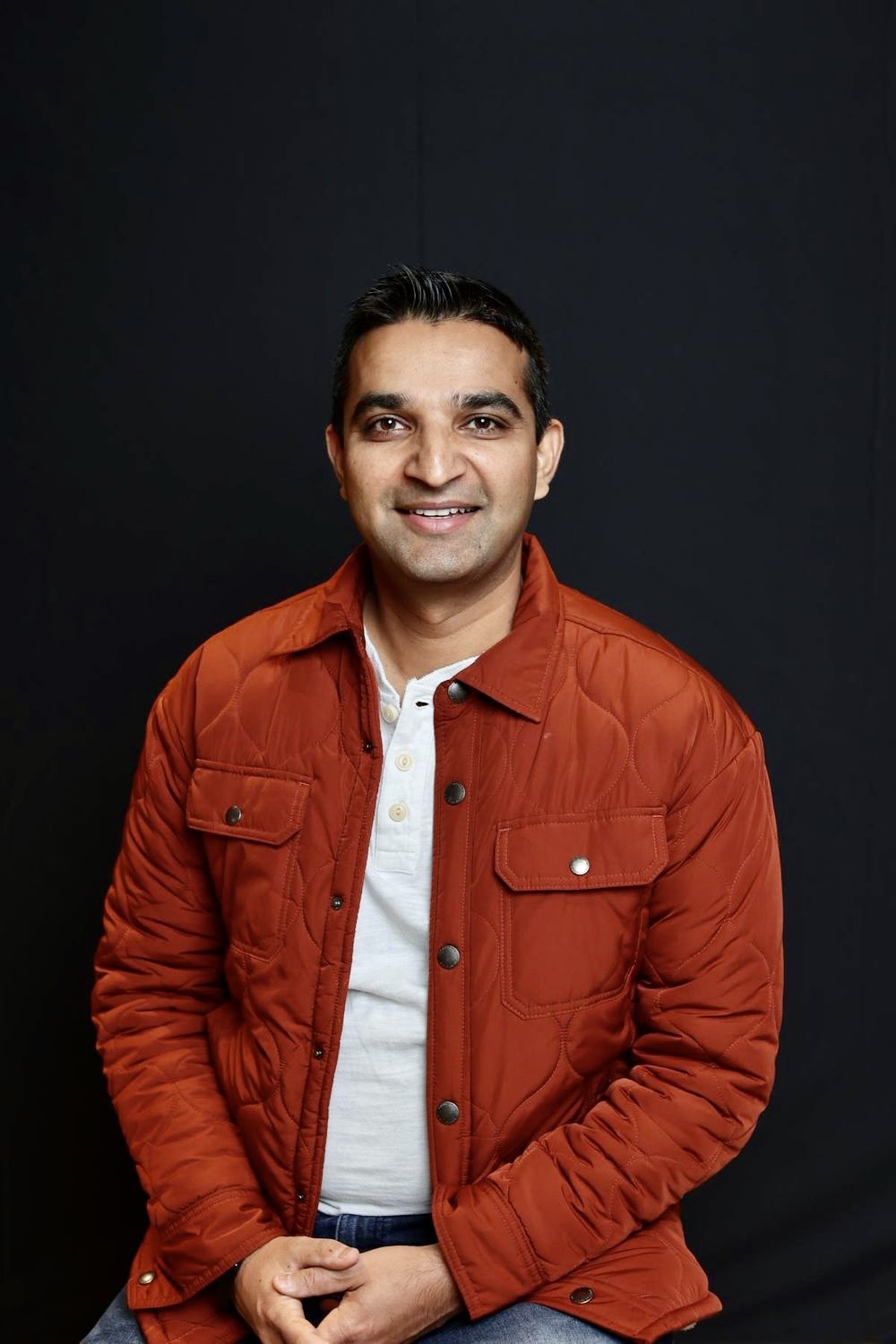November 1, 2023
 by Shashwat Ghosh / November 1, 2023
by Shashwat Ghosh / November 1, 2023

Ask any startup founder if you have a go-to-market (GTM) problem.
It's entirely possible that the answer would be no because startup founders and CXOs think that GTM is a top-of-the-funnel (TOFU) problem, marketing problem, product use case problem, or sales team problem.
And that’s the problem.
GTM has been around for a while and its various frameworks have mostly remained medieval. Your GTM framework should be a living document that you and your team regularly update and review every quarter, every six months, or whenever organizations create their annual operating plan (AOP). Unfortunately, most don’t.
Neglecting your GTM strategy leads to unwanted, unsold products and services, along with wasted time and resources. On the other hand, a well-defined GTM strategy helps your company target the right audience and make efficiency within the organization better.
Think of GTM as an evolving roadmap. Find a customer segment where a product is viable, a sale is repeatable, and an advantage is yours for the taking. If your experiment succeeds, plan to scale with all force, but keep the original variables intact. If your experiment fails, pivot till you get it right.
GTM has undergone significant changes in recent years. The frameworks are evolving and so are the definitions.
Traditionally, companies focused on the total addressable market (TAM) and serviceable addressable market (SAM) when developing their GTM framework.
%20%20%20(1).png?width=600&height=400&name=Total%20Addressable%20Market%20(TAM)%20%20%20(1).png)
%20.png?width=600&height=400&name=Serviceable%20Addressable%20Market%20(SAM)%20.png)
However, in the last few years, the focus has shifted to the serviceable obtainable market (SOM), where companies determine the market size based on the potential of their sales team.
So, today, if you as a company have only about 20 salespeople, each of those 20 salespeople can bring in five accounts every month. So, 100 accounts are likely obtainable by the company.
%20%20.png?width=600&height=400&name=Serviceable%20Obtainable%20Market%20(SOM)%20%20.png)
This shift has led to a more laser-focused approach to GTM. Companies now define their and tailor their strategies accordingly. For example, if a company is targeting e-commerce companies, it might focus on selling to companies like Flipkart and Myntra.
These companies are a good fit for the company's products and services, and they have the resources to implement them. By focusing on a specific set of ideal customer profiles (ICPs), the company can more effectively reach its target market and achieve its sales goals.
The founder-led approach to GTM has also become more prevalent, with founders pulling various levers, including sales-led and account-based marketing (ABM), to drive growth. Additionally, companies are focusing on product-led growth (PLG), marketing-led development, and community-led approaches to GTM.
Community-led marketing has become very important in the new GTM frameworks. It is a way for companies to create value for their customers outside of their products or services.

Every Thursday, we spill hot takes, insider knowledge, and news recaps straight to your inbox. Subscribe here
In the past, companies would often rely on traditional marketing channels, such as advertising and public relations, to reach their target market. However, these channels are becoming less effective as consumers become more ad-blind and distrustful of traditional marketing messages.
People have formed larger communities, whether it’s the browser stacks, Discord, or Slack communities. Answering the questions posed in these online communities is very important. When companies answer questions in a helpful and informative way, they show that they are knowledgeable about their industry and that they are committed to helping their customers. This can lead to increased brand awareness, more leads, and more sales.
Overall, the push-focused approach of the past has given way to a more informed and educated customer base that requires a sophisticated avenue to GTM. As a result, companies must adapt and evolve their GTM strategies to succeed.

Source: Helix Consulting
The GTM strategy is applicable across the various stages your company is in. Let’s explore it in detail.
Note: Churn is a crucial concern as you scale up. GTM strategies must remain consistent within their respective stages for effective growth.
In the context of GTM frameworks, it's essential to understand the sales cycle and how it has evolved.
Traditionally, the sales cycle would take around 8 to 12 months. You have a lot of TOFU, where you try to do the product demos, and make the discoveries. Then you can get into the POC and the pricing proposal. Then you either win or lose.

Source: Helix Consulting
However, in today's market, this approach is no longer sustainable, and companies are trying to crunch the timeline by adding more TOFU and focusing on SOM. The process now involves buying groups, a higher number of interactions before a sale, and informed buyers who have their own research. They don’t automatically trust the salesperson anymore.
With these changes, it becomes all the more important for companies to combine PLG and a GTM strategy to achieve this.
As entrepreneurs or CXOs seek midmarket and enterprise customers, they face the challenges of engaging leads, enduring long sales gestation periods, and maximizing customer lifetime value. The GTM approach, which used to work in 2020, is useless today. With the necessity of combining PLG and GTM models, I have created the EPIC model framework.

Source: Helix Consulting
The EPIC model approach to GTM aligns a company's four critical pillars so they run in sync. These pillars encompass ecosystem or sales-driven effort (E), product-led growth (P), inbound and outbound demand generation (I), and community-led engagement (C).
EPIC framework becomes the spine of your GTM strategy and aligns the entire company’s efforts into a strategy that propels you into the next galaxy. A successful approach prioritizes storytelling through all four pillars to attract TOFU leads, accelerate opportunities in the middle and at the bottom of the funnel, and build community word-of-mouth.
The sales team leads the ecosystem and account-based marketing (ABM) pillar. They determine the ICPs and external partners, such as analyst firms, trade associations, and publications, that can influence decision making.
For example, if you’re going to sell to the US market, the first thing a CIO will want to know is whether you have a presence on the G2 Grid. External partners become all the more important when you want to influence decision making.
Sales can’t do it alone. Gone are the times of superstar salespeople. Nowadays, they need to REACT in the ecosystem to meet their quotas.
Ecosystem stimulus using REACT framework
| Research (R) | Engage (E) | Adjacencies (A) | Chase (C) | Touch (T) |
| Qualitative Research | Event and Exhibitions | Partner Marketing | Consulting Firms | Account Based Experience (ABX) |
| Voice of Customer | Workshops | VAR/VAD/Reseller Program | PR and Analyst | T-O-P-S Account Research |
| Top-of-the-mind awareness (TOMA) or Spontaneous (SPONT) Awareness | Roundtables | OEM Partners | Trade Bodies | Customized Sales Enablement |
| Customer Satisfaction (CSAT) Research | Advisory Councils | Referral and Affiliate Partners | G2 and other Peer Review sites | Exec Sponsor Program |
Once you land an account, PLG will show you where you need to onboard, generate value, experiment, and expand. While other GTM channels are top to bottom, PLG moves from the bottom up. In India, many companies are adding newer products, so this upward movement becomes all the more important.
Try using PLG to remove the POC stage in sales and replace it with putting the product in the user’s hands. This experience actually reduces the time and costs of acquisition.
Similarly, you can target the buying cabinet with ABM, the end users with PLG, and the influencers with content. Along with eliminating smaller issues that consume time, disturb the product roadmap, and delay the actual value delivery, you can turn your 360° PLG approach into a self-serve model.
The third pillar is inbound and outbound, driven by marketing. This includes performance marketing, thought leadership content, and social media. The ad campaigns you run via LinkedIn and Google fall here, as well.
The brand element here is an integral part of GTM frameworks. If the brand is well-known, it generates inbound and outbound traffic, and customers will recognize and think of your product. However, the brand provides results over a long period and so we exclude it in the current model, which is results-focused.
The final pillar is community-led planning, which includes knowledge sharing, word of mouth, and peer reviews.
The focus has shifted from customer support to success in the past five years. In hand with this, the need for community engagement through customer advisory boards, or advocacy channels has grown. For instance, companies are now turning to advisory boards to gather feedback on their products and ensure that they address customer problems effectively.
These are the four pillars of the EPIC GTM strategy.
Like DNA, every company’s GTM is unique. You can’t cut-copy-paste it or replicate it in a silo.
Let’s take the GTM Partners’ and GTM Alliance models, two established and popular frameworks, and look at how the EPIC model differs from them.
GTM Partners' model calls for inbound, outbound, product-led, channel-led, and ecosystem-led growth as the key components of a successful GTM strategy. The EPIC framework is designed for emerging markets like India, the Middle East, and APAC.
The EPIC framework has a number of notable differences from the GTM Partners' model
The GTM Alliance model emphasizes the significance of ecosystem-led growth (ELG) as the primary approach. It also highlights the roles of sales, content, and community within this framework. However, I find the case is different when considering the Indian market.
In India, when we observe SaaS companies, only a select few have reached an advanced stage of PLG. While PLG is highly effective in the early stages (0 to 1 and 1 to 5), it becomes less prevalent as companies go beyond that. Therefore, relying solely on PLG may not guarantee success. This is the primary distinction between the EPIC and GTM Alliance models.
Content plays a vital role in different components of a GTM strategy, such as ecosystem-based sales, sales enablement, and ABM. However, it cannot function as an independent lever. Examine how you shape and tailor your content for various channels. It cannot have a one-size-fits-all lever. Each channel demands specific content strategies to be effective, which is what the EPIC model advocates.
The first important step is admitting the challenges you face. If you talk to ten founders, nobody will say, “I have a GTM problem.” They’ll talk about TOFU challenges, sales closure issues, or product shortcomings. This is a narrow, fragmented perspective. Leaders need to understand that their problem isn’t an individual one, but collective. It is a GTM problem.
Another challenge is the silos that exist between different teams. Leads and closures are sitting in two different places. Marketing gives out those leads and then you have no clue what happens to them.
While some marketers take pride in going after the leads, most don’t. And sales has a tendency to only pursue the good leads. What happens to everybody else? You – and all leadership – need to look at the process holistically and make sure your whole crew works on it together from start to finish.
You also have to consider the lack of resources and inconsistent literature available about these techniques. While the market has changed, educational institutions and knowledge shares haven’t caught up. It’s still difficult to pinpoint a resource for learning about GTM frameworks.
While every framework guides your GTM strategy, identifying the needs of the market you’re catering to and doing everything you can to fulfill them lie at the foundation of this process.
You should operate from a local market perspective no matter where you are. So if you’re in North America, certain practices hold true for that market. Take the relevant parts of the GTM framework that are applicable to the North American market and exclude the rest. For example, the EPIC framework applies to Indian markets, so I have taken the relevant aspects from the overall framework and appropriately tailored it.
And that's how you have to approach your GTM framework. There won't be a one-size-fits-all approach because the markets are not uniform.
Experiment and fail and try again when building a GTM framework that works for you. As you make decisions about your framework, take resilience, productivity, and profitability into account. Once your experiments are successful, you can scale.
With these fundamentals in place, you clearly define your ICP and your GTM will fine-tune itself.
Once you have a GTM framework that works for your company in place, how can you use AI advancements to reimagine a better way to engage your customers and grow more efficiently? Find the answers to these questions and more as you learn about a new AI framework for GTM teams.
Shashwat Ghosh is the CMO of FieldAssist. He is passionate about scaling up B2B startups for the last 6+ years and helping them achieve their potential. His pipeline marketing expertise, the ability to create compelling stories, and experience in demand generation make him a potent combo to help startups develop and execute 3X effective marketing campaigns. With 22+ years of experience developing and executing marketing strategies, he has developed a deep understanding of what it takes to drive results and achieve business goals.
Not redefining ROI yet? There's still time to adopt a new understanding of ROI that can...
 by Sangram Vajre
by Sangram Vajre
Can you sell AI products without mentioning AI?
 by Sidharth Yadav
by Sidharth Yadav
Did you know that tracking career transitions could help you sell more?
 by Sidharth Yadav
by Sidharth Yadav
Not redefining ROI yet? There's still time to adopt a new understanding of ROI that can...
 by Sangram Vajre
by Sangram Vajre
Can you sell AI products without mentioning AI?
 by Sidharth Yadav
by Sidharth Yadav


